Why Professional Body Cooling Systems Are Essential for Every Funeral Home
Body-mortuary-coolers-n151 units are specialized refrigeration systems designed to preserve human remains at optimal temperatures between 2°C and 4°C (35.6°F to 39.2°F). These systems slow decomposition, maintain dignity, and provide families essential time to grieve and plan services.
Key Features of Body-Mortuary-Coolers-N151:
- Temperature Range: 2-4°C (35.6-39.2°F) with digital controls
- Capacity Options: 2-6 bodies in standard units, up to 12+ in walk-in models
- Power Requirements: Standard 110V for compact units, 208-230V for larger systems
- Construction: Stainless steel interior, high-density insulation
- Energy Efficiency: Modern units reduce electricity consumption by up to 30%
When it comes to honoring loved ones who have passed away, providing dignified and respectful care is paramount. Modern mortuary coolers serve as the backbone of funeral home operations, ensuring proper preservation while families steer their most difficult moments.
The science behind effective body cooling is straightforward yet critical. Without proper refrigeration, natural decomposition begins within hours, creating challenges for funeral directors and additional stress for grieving families. Professional cooling systems maintain consistent temperatures that halt bacterial growth and preserve remains for weeks when needed.
During mass fatality events, temporary mortuary coolers can increase morgue capacity by up to 300%, helping facilities manage unexpected surges in demand. This capacity becomes essential during natural disasters, pandemics, or other community emergencies.
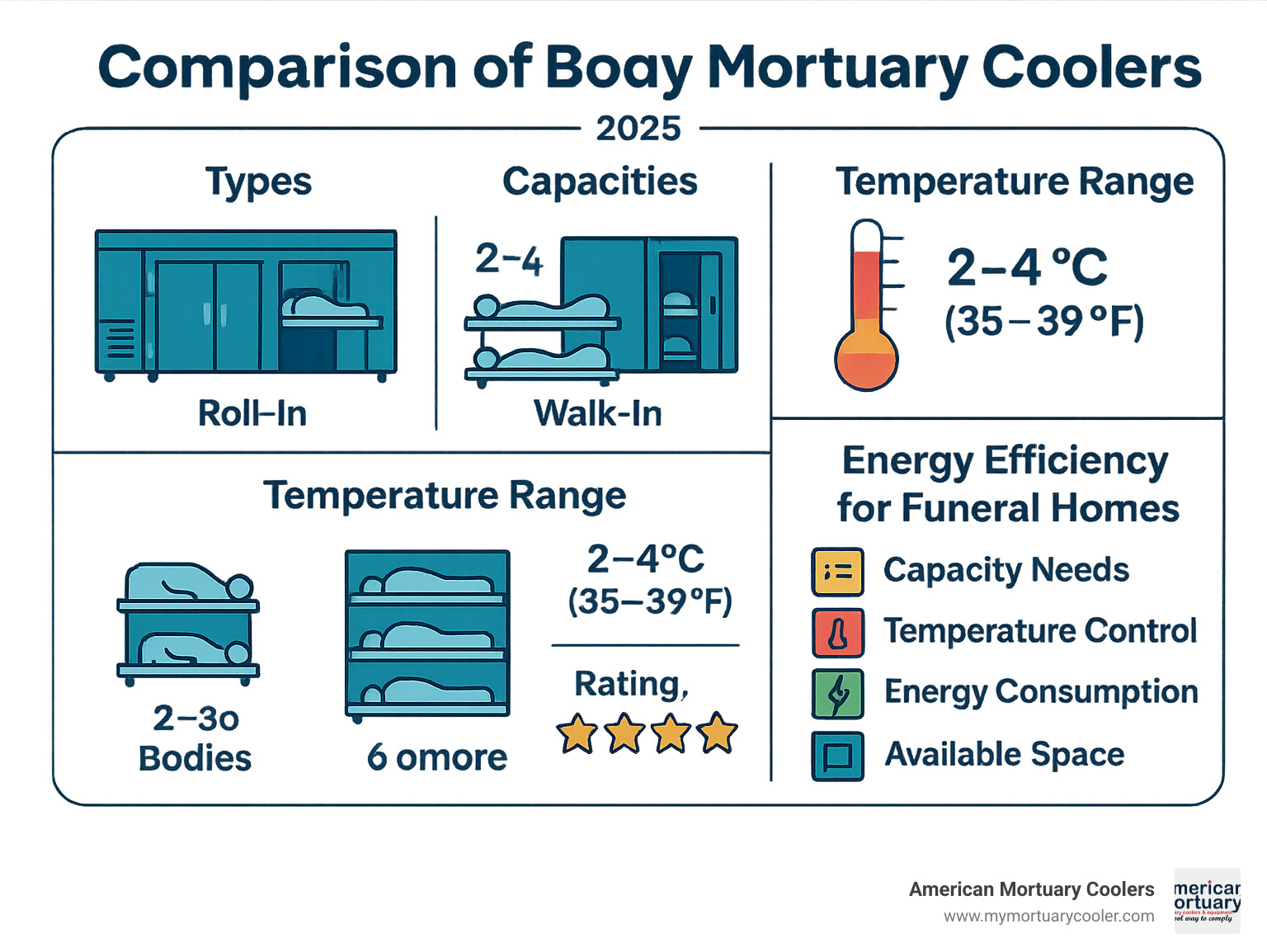
Why Proper Cooling Matters
The importance of proper body cooling extends far beyond basic preservation. When we maintain optimal temperatures within the first 4-6 hours after death, we effectively slow enzymatic activity that leads to decomposition. This preservation time allows families to grieve without the pressure of immediate decisions and gives funeral directors the flexibility to coordinate services properly.
From a workflow perspective, reliable cooling systems enable funeral homes to manage multiple cases simultaneously. Without adequate refrigeration capacity, facilities may need to rush services or turn away families during peak periods.
The emotional aspect cannot be understated either. Families deserve time to process their loss, gather relatives from distant locations, and plan meaningful services. Quality mortuary coolers provide this essential breathing room while maintaining the dignity and respect that every person deserves in their final journey.
Preservation Science & Core Specifications
When you understand the science behind body preservation, choosing the right cooling equipment becomes much clearer. The moment someone passes away, their body begins a natural process called decomposition. This happens through two main ways: autolysis (when cells break down from the inside) and bacterial activity that speeds up decay.
Body-mortuary-coolers-n151 systems use smart technology to create the perfect environment for preservation. They feature eco-friendly refrigerants like R-134a, thick insulation that keeps temperatures steady, and fans that circulate cool air evenly throughout the storage space.
The real magic happens with digital PID thermostats. These aren't your basic home refrigerator controls - they're precision instruments that maintain exact temperatures. When something goes wrong, built-in alarms immediately alert your staff with both sounds and visual warnings.
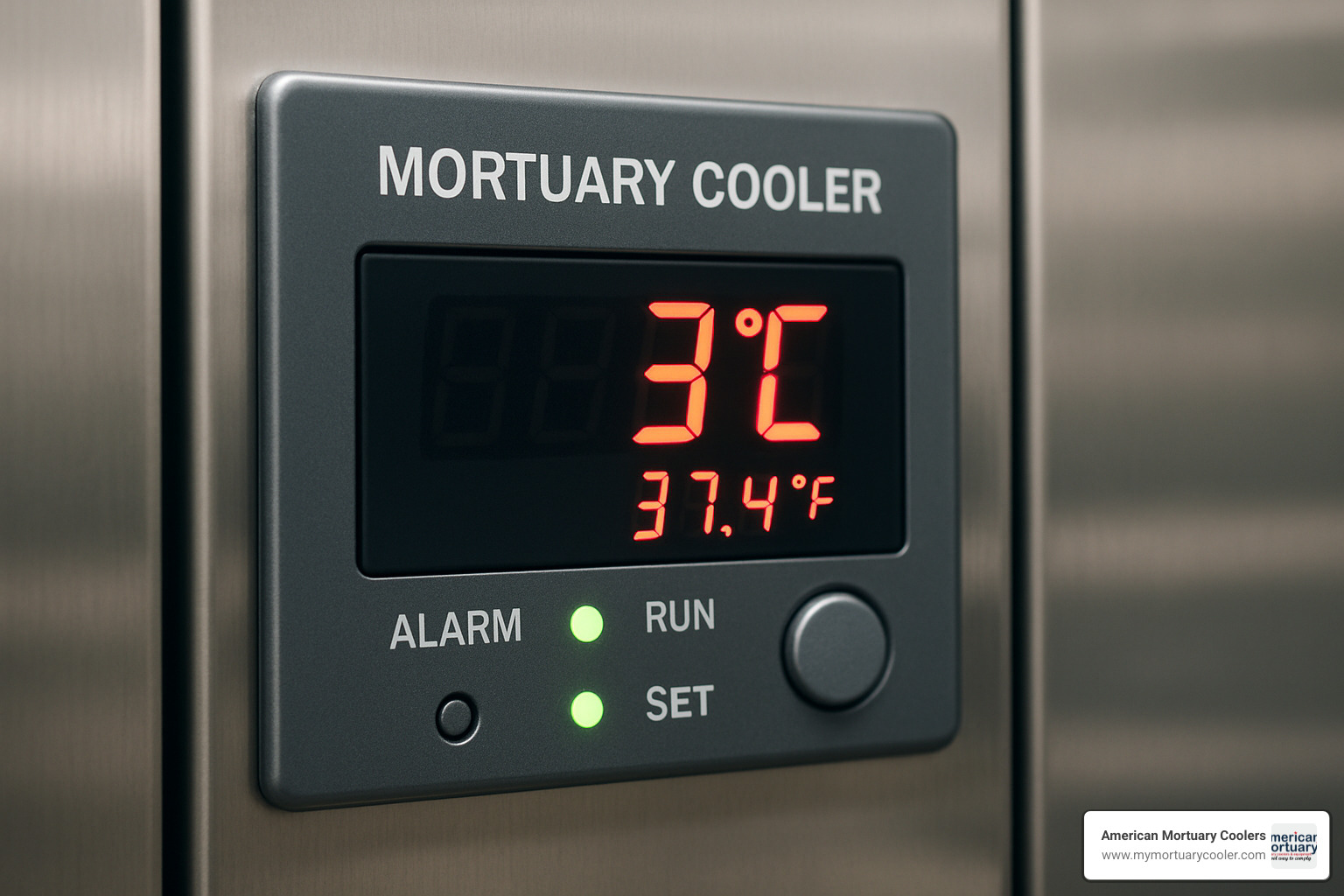
The Biology of Decomposition Slow-Down
At normal body temperature of 98.6°F, cells continue their metabolic processes even after death. But when you drop that temperature down to the optimal storage range of 34-38°F, those cellular activities essentially stop.
Bacteria that cause decomposition love warm environments. They multiply rapidly at room temperature but become almost completely inactive in properly cooled conditions.
Timing makes all the difference. Research shows that cooling within the first 2-4 hours provides the best preservation results. Wait too long, and those initial decomposition processes get a head start that's harder to reverse later.
Humidity control is just as important as temperature. Professional systems maintain the right moisture levels to prevent both dehydration and excess dampness - both of which can compromise how well remains are preserved.
Standard Performance Benchmarks
Industry-standard body-mortuary-coolers-n151 maintain that critical 2-4°C temperature range (that's 35.6-39.2°F) with rock-solid precision. Each tray can safely support up to 150 kg, which covers virtually every situation you'll encounter.
Energy-efficient models cut electricity costs by up to 30% compared to older systems. Over time, that adds up to real savings on your operating expenses.
Quality body-mortuary-coolers-n151 keep temperature variations within just ±1°C throughout the entire storage chamber. This means every person receives the same level of care, whether they're on the top tray or bottom tray.
Modern systems come loaded with safety features that give you peace of mind. Backup temperature sensors, battery-powered alarms, and emergency contact capabilities protect against equipment failure.
For funeral directors wanting to dive deeper into cooling techniques and industry best practices, this comprehensive resource on Cooling Techniques provides excellent additional guidance.
How Specs Translate to Preservation Time
Short-term preservation covering 24-72 hours works well with most professional cooling systems. This timeframe handles the majority of cases where families schedule services within a few days.
Extended preservation lasting weeks or even months requires more sophisticated environmental controls. These situations come up during forensic investigations, when families need time to gather from across the country, or during legal proceedings that delay services.
During disaster response scenarios, surge capacity becomes absolutely critical. Walk-in systems and modular configurations can dramatically expand your storage capacity when your community faces unexpected challenges.
Comparing Cooler Types & Capacities
Choosing the right mortuary cooler feels a bit like finding the perfect pair of shoes – it needs to fit your space, match your budget, and handle everything you throw at it. The good news is that body-mortuary-coolers-n151 systems come in several configurations, each designed for different funeral home needs.
A small rural funeral home handling one service at a time has very different needs than a busy urban facility managing multiple families simultaneously. That's why manufacturers offer everything from compact body boxes that fit in tight spaces to massive walk-in systems that can handle surge capacity during difficult times.
The main categories break down simply. Body boxes are your compact workhorses, upright cabinets maximize vertical space when floor space is tight, walk-in systems provide maximum flexibility for larger operations, and portable solutions offer backup or specialized cooling when you need it most.
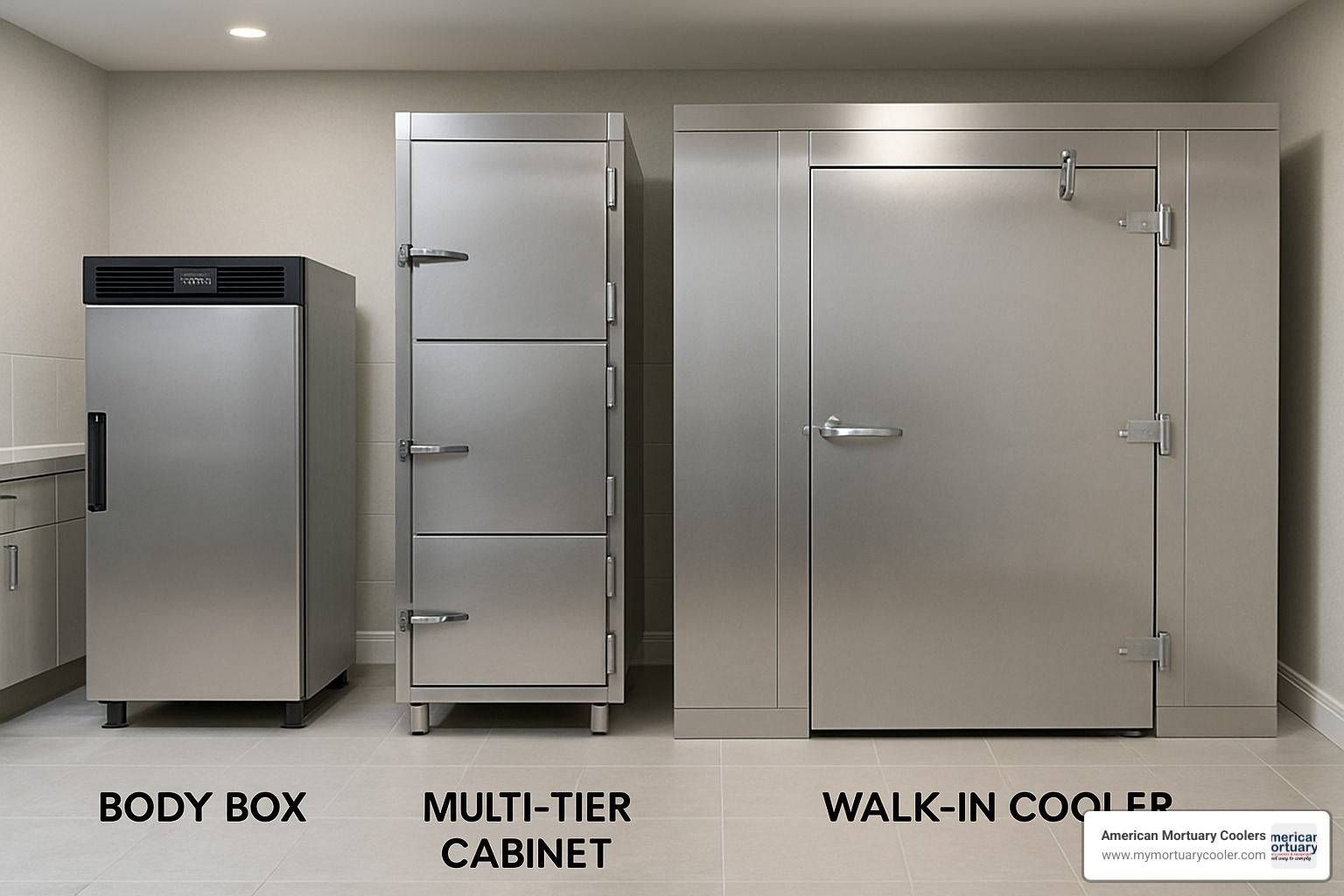
Single & Double Body Boxes
Body boxes are the reliable workhorses of the mortuary cooling world. These self-contained units typically measure around 7'3" × 3'¾" × 5'2" on the outside – about the size of a large commercial refrigerator. The beauty of these systems is their simplicity: plug them into a standard 110V outlet, and they're ready to work.
Rural funeral homes absolutely love these units. When you're handling one to three cases at a time, a compact body box gives you exactly what you need without eating up precious preparation room space.
The mobility factor shouldn't be overlooked either. Optional casters let you roll these units wherever you need them most. During busy periods, you might want the cooler closer to your preparation area.
Modern body boxes have become remarkably energy efficient too. Units drawing just 8.3 amps at 115V provide reliable cooling while keeping your electrical bills reasonable.
Multi-Tier Upright Cabinets
When floor space is at a premium but you need more capacity, upright cabinets with telescopic rack systems become your best friend. These clever units stack 2-6 bodies vertically while taking up roughly the same footprint as a single body box.
The telescopic sliding system is really where these units shine. You can pull out any tray for easy access without disturbing the others. It's like having a filing cabinet for bodies – everything stays organized and accessible.
Most funeral homes find that three-tier systems hit the sweet spot between capacity and practicality. You get triple the storage without making staff climb ladders or strain their backs.
Type 304 stainless steel construction in these upright units means they'll look professional and clean up easily for years to come. The removable trays make thorough sanitization straightforward.
Walk-In & Vault Systems
Walk-in mortuary coolers are the ultimate solution for high-volume operations. These systems typically handle 10-12+ bodies while giving staff enough room to work comfortably inside the cooled environment. During mass fatality events or unexpected surges, these systems can temporarily accommodate significantly more remains using additional portable rack systems.
The construction standards for walk-in systems exceed everything else in the industry. All panels must comply with the Federal Energy Independence & Security Act of 2007, ensuring top-tier energy efficiency. Four-inch high-density, no-wood insulated panels provide superior thermal performance that keeps operating costs reasonable even with larger spaces.
Customization options really set walk-in systems apart. You can specify exact dimensions to maximize your available space, choose floor configurations that work with your workflow, and select door arrangements that make sense for your facility layout.
For detailed guidance on selecting the right walk-in system, check out our More info about walk-ins.
Portable & Alternative Solutions
Sometimes you need cooling solutions that think outside the box – literally. Portable cooling options serve specialized situations like home funerals, disaster response, and temporary capacity expansion when your main systems are overwhelmed.
The CuddleBlanket system represents innovative thinking in portable cooling. Using thermoelectric (Peltier effect) technology in a flexible blanket format, it allows body cooling in non-traditional settings where conventional refrigeration isn't practical.
DIY solutions like the CoolBot system have gained popularity among budget-conscious funeral homes. By pairing standard air conditioners with specialized controllers, facilities can create effective walk-in coolers at a fraction of traditional costs.
Dry ice and polymer refrigerants provide natural alternatives for green burial families and home funeral situations. These methods require careful handling and proper ventilation, but they offer chemical-free cooling that aligns with natural burial philosophies.
Selecting the Optimal body-mortuary-coolers-n151
Finding the perfect body-mortuary-coolers-n151 system for your funeral home isn't just about picking the biggest or cheapest option. It's about understanding your unique needs and matching them with the right equipment that'll serve your families well for years to come.
We always tell our clients to start with an honest look at their workload. How many cases do you handle in a typical month? What about during your busiest seasons? And here's the important part - what happens when you get hit with an unexpected surge? Building in that extra capacity cushion can save you from some very stressful situations down the road.
Your building will have the final say on many decisions. That beautiful walk-in cooler might be perfect for your needs, but if your floor can't handle the weight or your electrical panel is already maxed out, you'll need to explore other options.
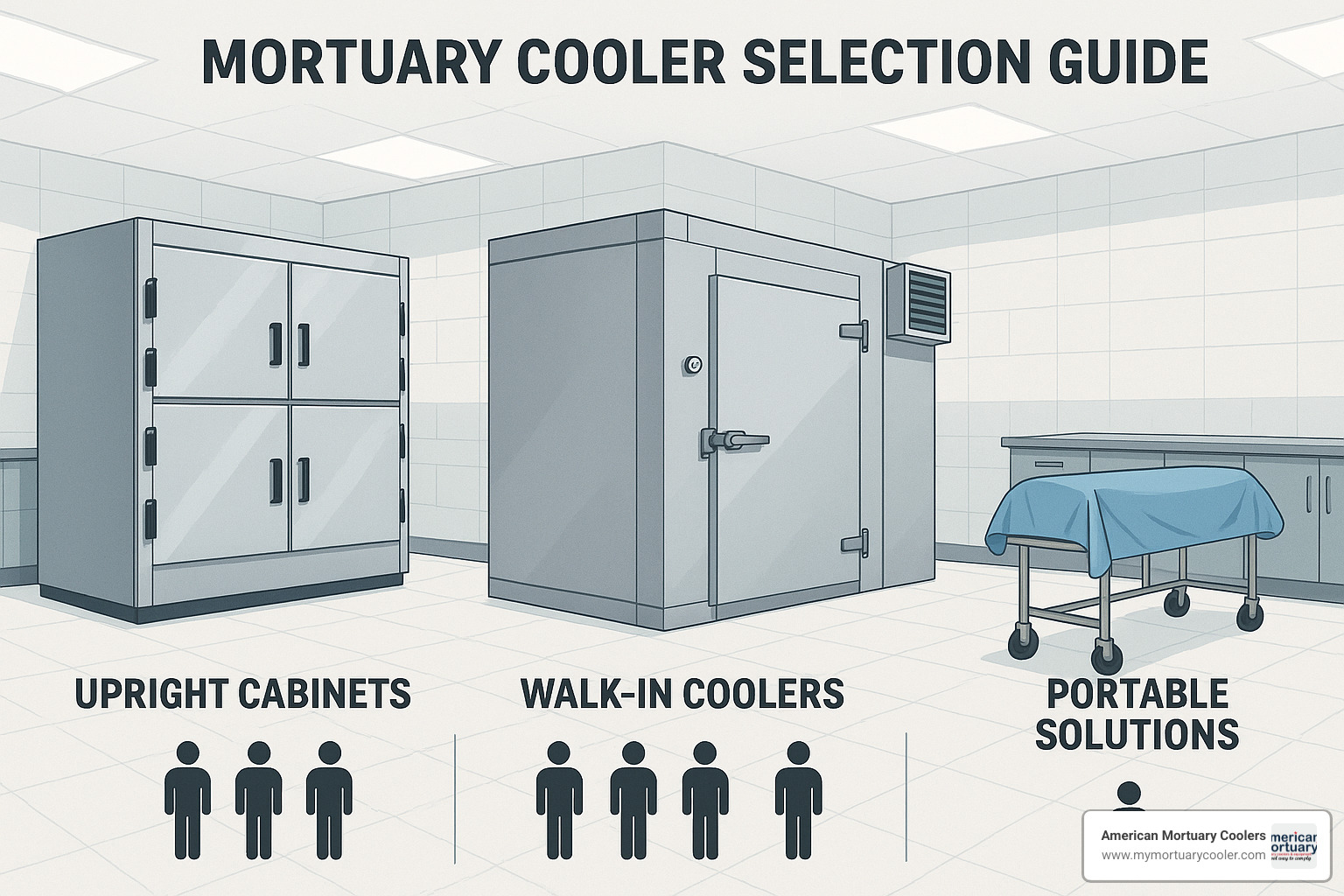
Key Buying Factors for body-mortuary-coolers-n151
Capacity matching is where we see most funeral homes make their biggest mistakes. Too small, and you're scrambling during busy periods. Too large, and you're paying for space and energy you don't need. We recommend taking your peak capacity needs and adding about 25% as a safety buffer.
Your local climate plays a bigger role than most people realize. If you're in Arizona dealing with 110°F summers, your cooling system works much harder than one in Minnesota. Those ambient climate conditions directly impact both performance and energy costs.
Power supply requirements can surprise people during installation. Those compact 110V units are plug-and-play simple, but they have capacity limits. Larger systems need 208-230V power, which might mean electrical upgrades.
When it comes to budget versus lifecycle costs, we've learned that the cheapest upfront option rarely saves money long-term. Energy-efficient units cost more initially but can cut your electricity bills significantly over their lifespan. Warranty coverage varies widely too - premium units often include 15-year panel warranties and 5-year mechanical coverage that cheaper alternatives don't match.
For a complete look at available options and current pricing, check out our Quality Embalming Supplies collection.
Future-Proof Features & Upgrades
Smart technology is changing how body-mortuary-coolers-n151 systems operate. IoT temperature alerts through WiFi-enabled monitoring mean you can check your cooler's status from anywhere. Get a temperature alarm at 2 AM? You'll know immediately instead of finding a problem Monday morning.
These systems maintain detailed historical logs and can send emergency notifications to multiple staff members.
Eco-friendly refrigerants like R-134a aren't just better for the environment - they're also better for your wallet. Older refrigerants are being phased out, which means expensive retrofits down the road. Choosing systems with modern refrigerants protects you from future regulatory changes.
Energy efficiency keeps improving too. Today's units can be 30% more efficient than models from just a few years ago. That efficiency improvement pays dividends every month on your electric bill.
Surveillance access logs and security features address growing concerns about facility security. These systems can track who accessed the cooler and when, providing comprehensive audit trails.
The key is thinking beyond just today's needs. What will your funeral home look like in five or ten years? Choosing systems with upgrade potential and modern features helps ensure your investment serves you well into the future.
Installation, Compliance & Maintenance Best Practices
Getting your body-mortuary-coolers-n151 system installed properly makes all the difference between smooth operations and costly headaches down the road. We've seen too many funeral homes struggle with cooling issues that could have been prevented with proper installation planning.
Site preparation goes far beyond just clearing floor space. Your building needs to handle the weight, provide adequate electrical capacity, and meet ventilation requirements. We always recommend professional installation - it protects your warranty coverage and ensures everything works correctly from day one.
Load-bearing capacity becomes especially important with walk-in systems and large upright units. Most concrete floors handle the weight just fine, but older buildings with wooden floors often need reinforcement.
Proper drainage prevents water problems from condensation and cleaning activities. A small floor drain can save you from major water damage later.
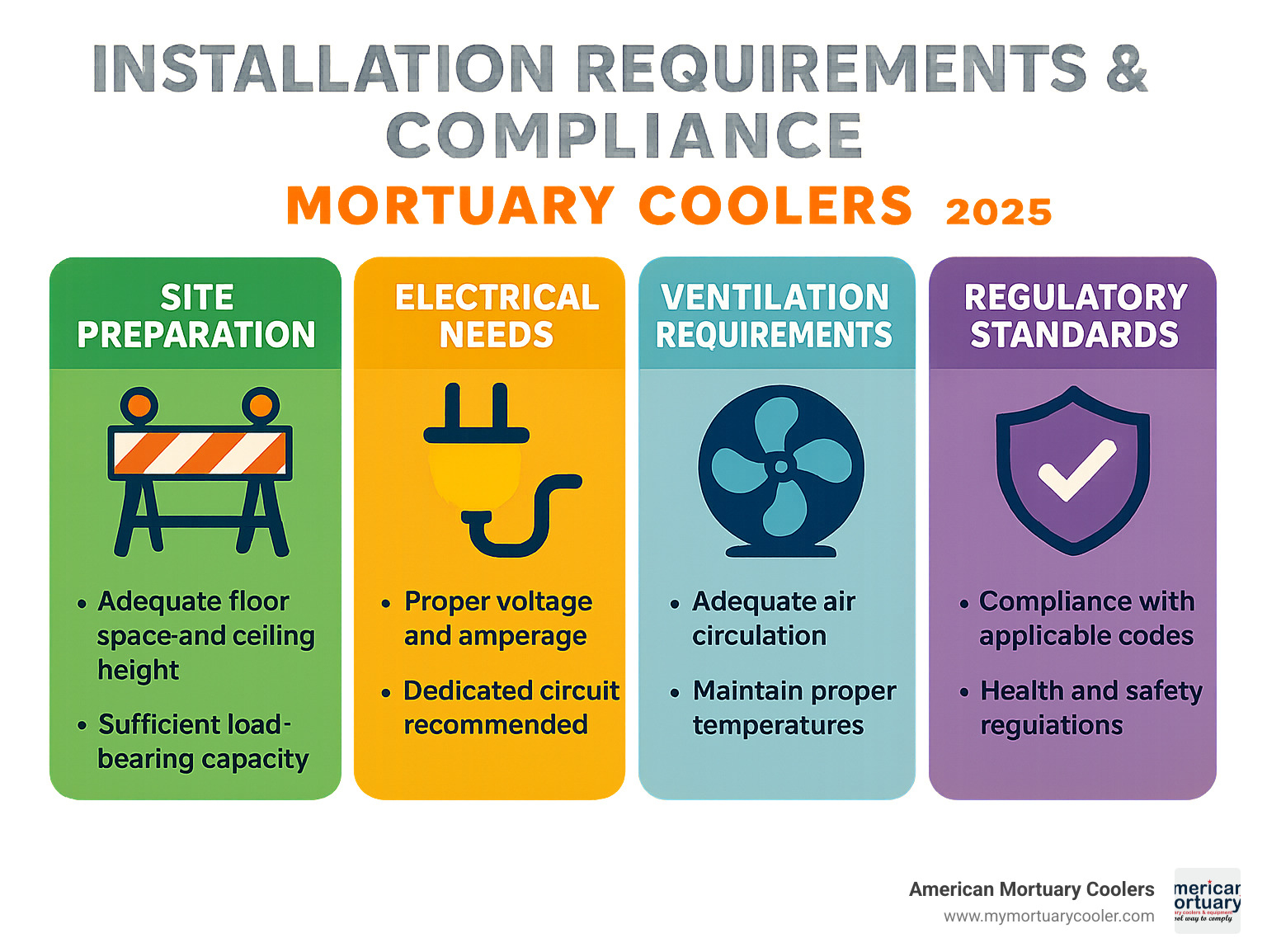
Environmental Factors & Mitigation
Your cooling system works hardest when fighting against hot, humid conditions. Most manufacturers void warranties if ambient temperatures exceed 95°F consistently. If your prep room gets sweltering in summer, you might need better ventilation or air conditioning to protect your investment.
Humidity levels above 60% create condensation problems that reduce cooling efficiency and make everything damp and unpleasant. Good building ventilation and dehumidification systems keep conditions comfortable for both your equipment and staff.
Voltage fluctuations can damage sensitive electronic controls in modern cooling systems. Areas with unstable power supplies benefit from voltage stabilizers - they're much cheaper than replacing fried control boards.
Generator backup systems become essential if your area experiences frequent power outages. Size your generator to handle the cooling system's electrical draw during extended outages.
Routine Maintenance Schedule
Daily temperature logging keeps your system running smoothly and satisfies regulatory requirements. Digital systems automate most of this work, but we still recommend visual checks - technology occasionally hiccups when you least expect it.
Weekly sanitization of interior surfaces prevents odor buildup and maintains hygiene standards. A simple cleaning routine takes just minutes but makes a huge difference in working conditions.
Monthly maintenance should cover door gasket inspection, condenser coil cleaning, and alarm system testing. Dirty coils make your compressor work harder and drive up electricity bills.
Quarterly professional servicing addresses refrigerant levels, electrical connections, and mechanical wear patterns. Catching small problems early prevents expensive emergency repairs during your busiest times.
Annual comprehensive inspections help identify potential issues before they cause system failures. Well-maintained body-mortuary-coolers-n151 systems often operate effectively for 15-20 years, while neglected units may need major repairs within 5-10 years.
This cooling blanket case study demonstrates how proper maintenance protocols extend equipment life and maintain performance standards.
Regulatory & Ethical Essentials
State health codes typically mandate temperature maintenance between 34-38°F for mortuary cooling systems. Most jurisdictions require documentation proving compliance with temperature standards. Keep those temperature logs - inspectors will ask for them.
CDC guidelines provide additional recommendations for infectious disease cases and mass casualty situations. These guidelines become especially important during pandemic conditions or disaster response scenarios.
Cultural sensitivity affects how you select and operate cooling systems. Some religious traditions have specific requirements for body handling and storage that influence equipment choices.
PPE protocols protect staff working with cooling systems and include appropriate protective equipment plus sanitization procedures. Regular training ensures everyone understands both technical operation and safety requirements.
Documentation requirements extend beyond temperature logs to include maintenance records, cleaning schedules, and staff training documentation. Organized record-keeping simplifies regulatory inspections and demonstrates professional standards.
Our Ultimate Checklist for Buying a Morgue Cooler provides comprehensive guidance on regulatory compliance and installation planning.
Frequently Asked Questions about body-mortuary-coolers-n151
We get a lot of questions from funeral directors looking to upgrade their cooling systems or install their first professional unit. Here are the most common concerns we hear, along with straightforward answers based on our years of experience helping funeral homes across the country.
What temperature should a body-mortuary-coolers-n151 maintain?
Your body-mortuary-coolers-n151 system needs to maintain temperatures between 34-38°F (1-3°C) for proper preservation. This isn't just a suggestion - it's the sweet spot where decomposition essentially stops while avoiding the problems that come with freezing.
Modern digital thermostats make temperature control much easier than the old dial systems. The digital controls maintain precision within ±1°C throughout the entire storage chamber, so you don't have hot or cold spots that could compromise preservation quality.
The audio-visual alarms are honestly a lifesaver. They'll alert you immediately if temperatures drift outside the safe range, whether it's due to a door left open, mechanical issues, or power problems. We've had funeral directors tell us these alarms have saved them from major headaches more times than they can count.
For shorter storage periods of 24-72 hours, you can safely use the higher end of the temperature range around 37-38°F. But if you're looking at extended storage for any reason, keeping temperatures closer to 34°F provides that extra margin of safety.
How many bodies can one unit store safely?
This really depends on what type of system you're considering. Our compact body boxes handle 1-2 bodies comfortably, making them perfect for smaller funeral homes or rural facilities that don't need massive capacity.
Multi-tier upright cabinets step things up significantly, accommodating 2-6 bodies using telescopic rack systems. These are popular because they maximize your storage without taking up too much floor space - something every funeral director appreciates.
Walk-in systems are where you get serious capacity. Standard configurations handle 10-12+ bodies easily, but during emergency situations, we've seen facilities temporarily store 20+ bodies by adding extra rack systems. It's not ideal for long-term use, but it's reassuring to know the capability exists when your community needs it.
Each tray supports up to 150 kg (330 lbs), which covers the vast majority of cases you'll encounter. When you're planning capacity, think about your busiest periods and add about 25% buffer. You never want to be in a situation where you're turning families away because you don't have adequate cooling space.
What power supply is required for body-mortuary-coolers-n151 units?
The power requirements really depend on the size of unit you're installing. Our compact self-contained units run on standard 110V power - they literally plug into a regular wall outlet like a large appliance. These units typically draw 8-10 amps, so most existing electrical systems can handle them without any upgrades.
Walk-in systems and larger units are a different story. They require 208-230V three-phase power, which means you'll need a qualified electrician for installation. It's not something you can DIY, but the professional installation ensures everything is done safely and up to code.
Energy efficiency has improved dramatically in recent years. The newer body-mortuary-coolers-n151 models use about 30% less electricity than older systems, which adds up to real savings on your monthly utility bills. Over the life of the equipment, those energy savings can be substantial.
One thing we always recommend is considering backup power options. A generator system sized for your cooling equipment can be a real lifesaver during extended outages. Even basic battery backup for the temperature monitoring and alarm systems provides peace of mind when the power goes out.
Conclusion & Next Steps
Choosing the right body-mortuary-coolers-n151 system isn't just about buying equipment—it's about investing in your ability to serve grieving families with the dignity and respect they deserve. Every decision you make, from capacity planning to energy efficiency, directly impacts how well you can support your community during their most difficult moments.
At American Mortuary Coolers, we understand that no two funeral homes are exactly alike. That's why we craft custom mortuary coolers right here in Tennessee, custom to each facility's unique needs. Whether you're running a small rural operation or managing a high-volume urban facility, we design solutions that fit your space, your workflow, and your budget.
Our direct delivery service spans all 48 contiguous states, bringing Tennessee craftsmanship straight to your door. We've helped funeral homes from Johnson City, TN to Los Angeles, CA find the perfect cooling solutions for their operations. This personal approach means you're not just buying equipment—you're partnering with a team that understands the funeral industry inside and out.
The mortuary equipment landscape keeps evolving, and that's actually good news for funeral directors. Modern systems offer 30% better energy efficiency than older models, smart technology integration for remote monitoring, and eco-friendly refrigerants that protect both your budget and the environment. Investing in quality equipment today means decades of reliable service ahead.
Here's what we strongly recommend: don't go it alone when selecting cooling equipment. The market offers everything from compact 2-body units perfect for smaller facilities to massive walk-in systems that can handle surge capacity during emergencies. Our team provides comprehensive analysis of your operational needs, facility constraints, and budget realities to recommend the optimal solution.
The numbers tell an interesting story too. The global mortuary equipment market is projected to reach $1.2 billion by 2027, growing at 6.5% annually since 2020. This growth reflects something we see every day—funeral homes increasingly recognize that professional equipment isn't just nice to have, it's essential for providing quality service.
For detailed information about our complete range of solutions, specifications, and custom options, visit our Comprehensive Guide to American Mortuary Coolers. Our experienced team stands ready to help you select equipment that truly serves your community with the dignity every family deserves.
The right cooling system becomes invisible to your daily operations—it simply works, day after day, allowing you to focus on what matters most: caring for families when they need you most.


















